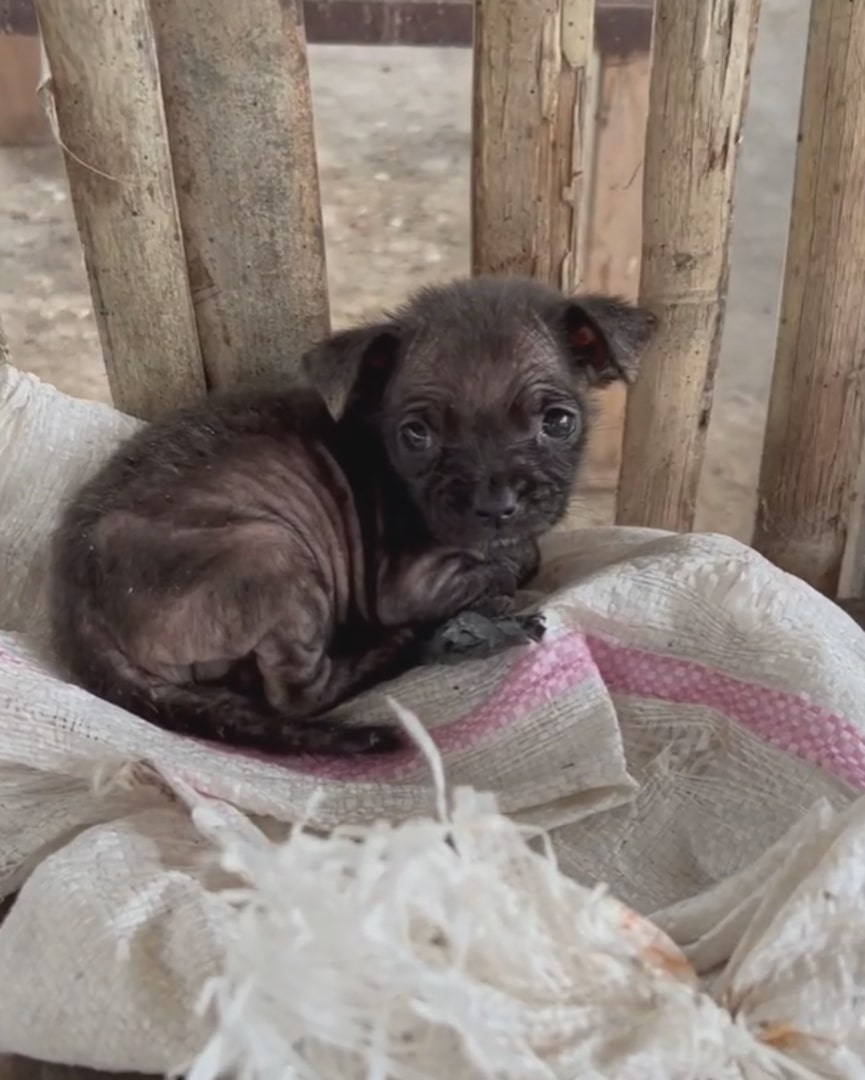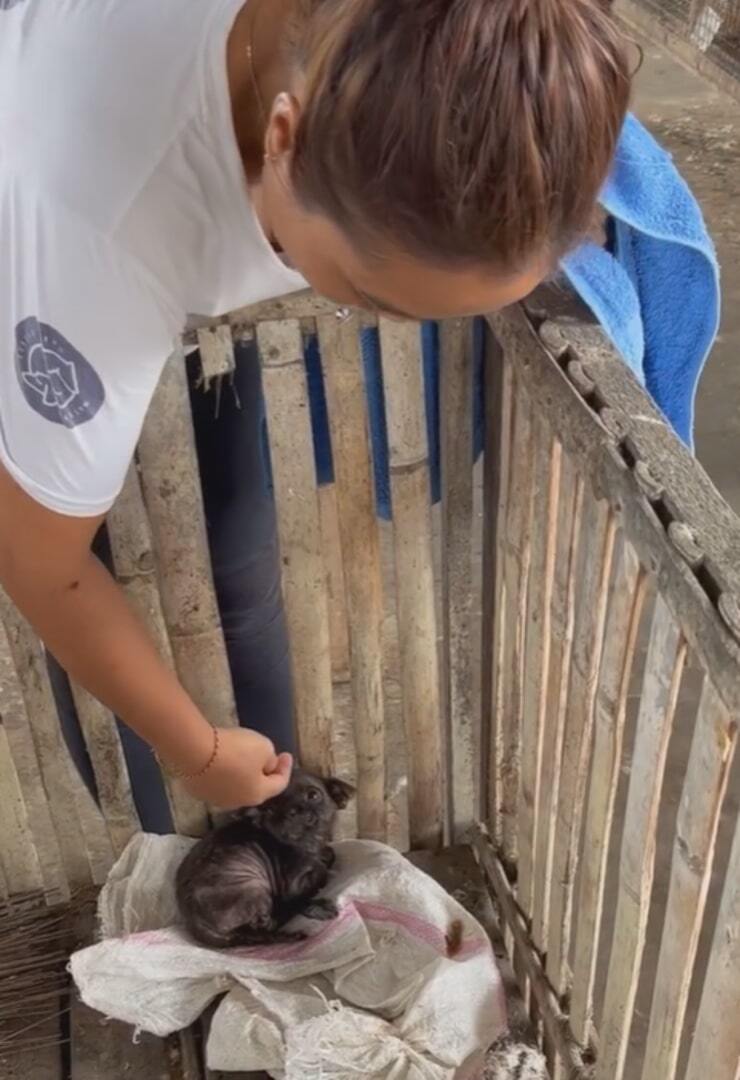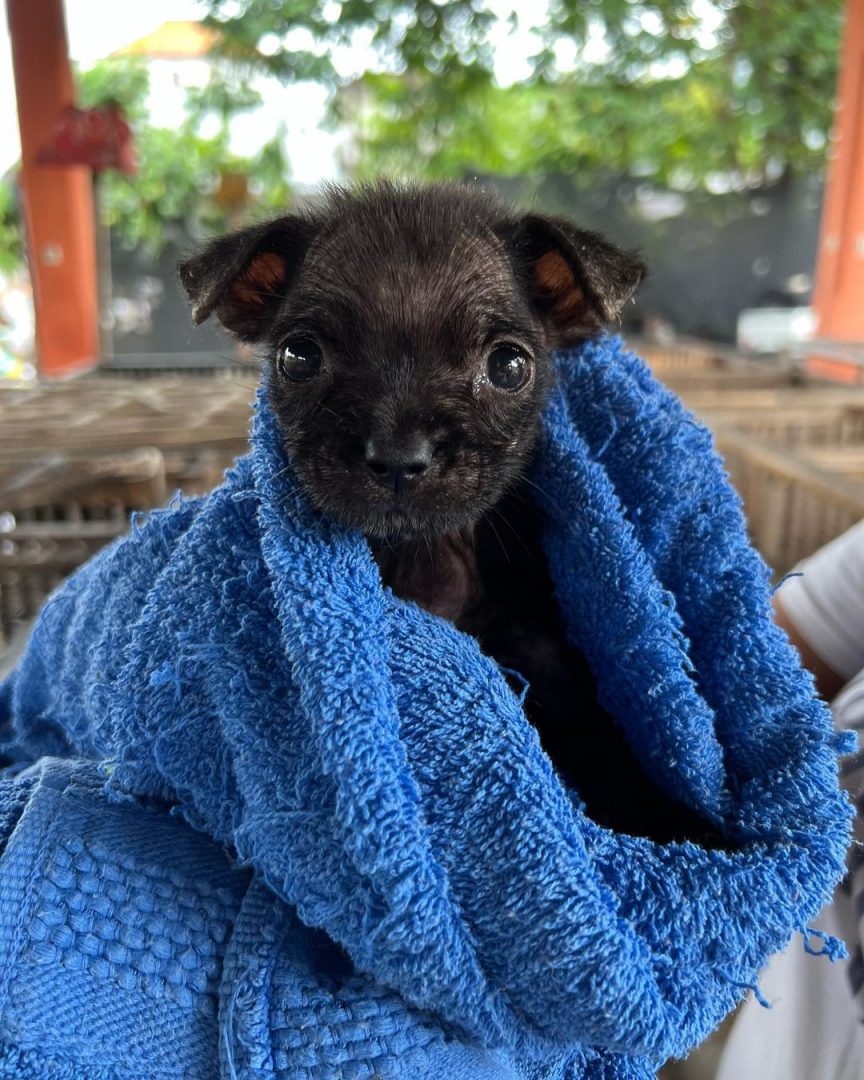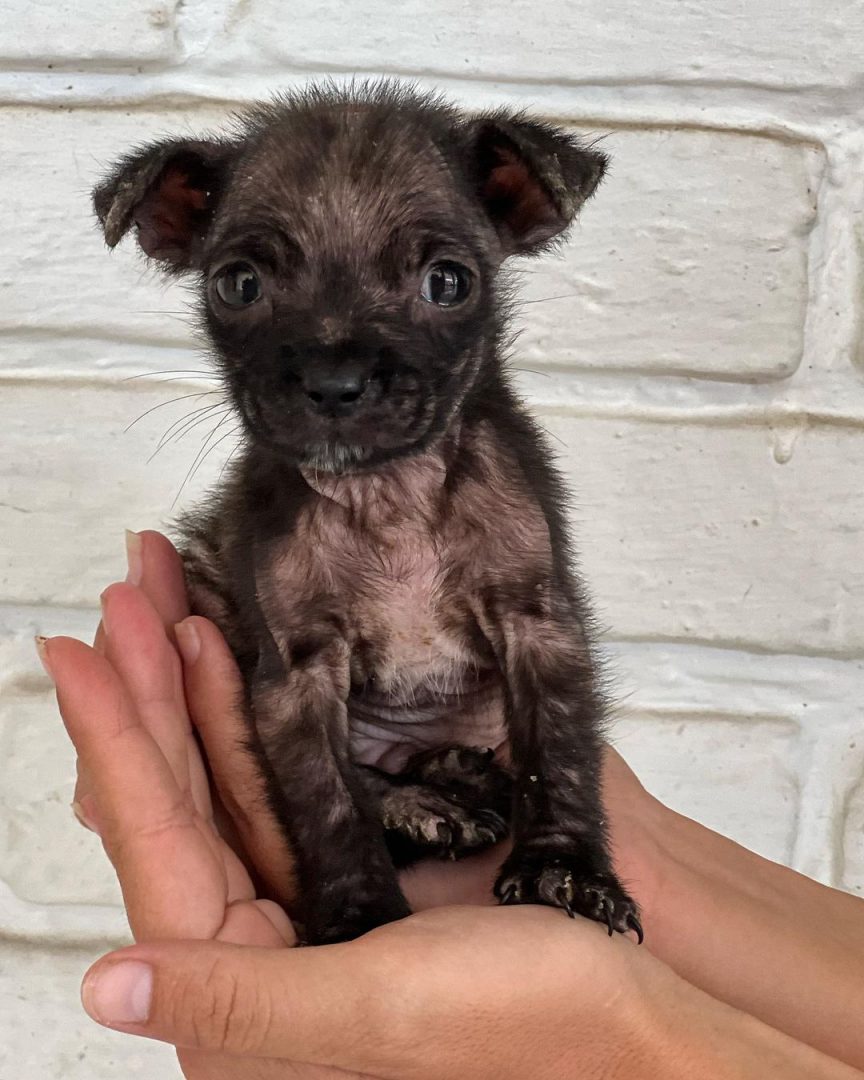Just when you think you’ve seen it all, a cold act of cruelty breaks your heart again.
A group of kind rescuers was shocked when they stumbled upon an open rice bag at one of the local markets. When they approached a little closer, they realized that the bag wasn’t empty and it was moving.
What they found inside the next moment truly shattered their hearts into a million pieces!
A Heartbreaking Rescue

“He was dumped by an anonymous person who disappeared as quickly as they could, not wanting to be seen throwing away a living being like he was nothing,” the LSM wrote on Instagram.
He was helplessly lying in a rice bag in a chicken pen, cold and shivering in fear of everything. After an initial examination of the pup, the rescuers learned the heartbreaking truth – Pino was left there because of his condition.

“We found this tiny dog curled up in a chicken pen. He was cold and shivering in fear when we approached him. This poor little bo was most likely dumped because he had mange,” his rescuers told The Dodo.
Without the proper help, this 1.5-pound baby was sentenced to starvation and was only days away from the point of no return.
Luckily, the kind people at Little Steps Matter arrived at the spot at just the right time!

And, the diagnosis was quite bad!
This heartbroken, yet resilient pup suffered from a severe case of mange and was very emaciated. The good part of his fur was missing, and he needed treatment – urgently!
The LSM team, known for their amazing rescues over the years, embraced Pino as one of their own family members. He was welcomed with arms and paws wide open, and his cheerful spirit soon captivated the hearts of everyone in the safe house!
Pino’s Miraculous Transformation

In just a few weeks of treatment, he was officially doing much better.
He started eating properly and already gained some healthy weight. Pino was completely out of his shell, starting to display his one-of-a-kind personality everywhere he went.
Then came another blissful moment!

Pino’s fur grew back – and now he looked nothing like his old self!
He was practically a brand-new dog, with his shiny, black coat that helped him charm his way everywhere. Pino became a confident, young pup that enjoyed the company of his furry buddies, and now – he was ready for a home of his own!

As for Pino, he’s finally learning the meaning of a forever home with his doggo sister, Mellie.
“Seeing him now to find out what family means, just fills our hearts with so much happiness. We hope sweet Pino, it is everything you ever dreamed of and more,” the LSM team wrote.
Once an abandoned boi waiting for the inevitable, Pino is now a brand-new dog who takes on life adventures with the biggest smile on his face!
If you’ve ever wondered about the ins and outs of your furry friend’s heat cycle, you’re not alone. Understanding how long dogs are in heat is essential for any dog owner. This natural biological process can vary in duration depending on the breed and individual dog. As a seasoned dog trainer, I’ve witnessed firsthand the importance of being well-informed about this topic.
Being aware of the length of your dog’s heat cycle is crucial for their health and well-being. It’s a fascinating aspect of canine biology that every dog owner should familiarize themselves with. So, if you’re curious about this aspect of your dog’s life, stick around as we explore this topic further.
Understanding the Heat Cycle in Dogs
During a dog’s heat cycle, it’s crucial to grasp the process to ensure the well-being of your furry friend. Here’s a breakdown to help you navigate this natural biological phase:
1. Length of Heat Cycle
The heat cycle in dogs typically lasts around 2 to 4 weeks. However, this can vary depending on the breed and the individual dog. Smaller breeds might have shorter heat cycles than larger breeds.
2. Stages of the Heat Cycle
- Proestrus: This initial stage can last for about 9-10 days, during which you may notice some bleeding and behavioral changes.
- Estrus: The fertile phase can last around 5-14 days, where the female is receptive to mating.
- Diestrus: After the estrus stage, the dog may show signs of pregnancy, whether they are pregnant or not.
- Anestrus: This is the resting phase before the cycle starts again.
3. Signs of Heat
- Swollen vulva
- Discharge
- Increased urination
- Changes in behavior (restlessness, increased affection, or aggression)
4. Frequency of Heat Cycles
Most dogs experience heat every 6 to 8 months, but this can vary. Younger dogs might have more irregular cycles until they mature.
Understanding your dog’s heat cycle is essential for their health. Keep track of the cycle, note any abnormalities, and consult your vet if needed. Being aware of these natural processes helps you ensure your dog’s comfort and well-being.
Stages of the Heat Cycle
Understanding the stages of the heat cycle in dogs is crucial for every dog owner. Here are the key stages you should be aware of:
- Proestrus Stage: This initial stage marks the start of the heat cycle. It typically lasts around 9 days, but it can vary between 4 and 20 days. During this time, your dog may experience vaginal bleeding and attract male dogs, although she’s not yet ready to mate.
- Estrus Stage: Following the proestrus stage comes the estrus stage, where your dog is fertile and ready to mate. This stage usually lasts for about 5 to 13 days, but again, the duration can vary. Your dog may be more receptive to male dogs during this time.
- Diestrus Stage: After the estrus stage, the diestrus stage follows. If mating hasn’t occurred, your dog will reach this stage, which indicates the end of her heat cycle. It can last around 60 to 90 days.
- Anestrus Stage: The anestrus stage is a resting period between heat cycles. It’s a time when your dog’s reproductive system takes a break, typically lasting around 4 to 5 months.
Understanding these stages and the behaviors associated with each can help you better care for your furry friend. Remember, every dog is different, so observing your dog’s behaviors and consulting with your vet can ensure her health and well-being throughout her heat cycles.
Signs and Symptoms of a Dog in Heat
When your dog is in heat, there are clear signs and symptoms to watch out for. Here’s what to look for during this time:
- Swollen Vulva: One of the most noticeable signs is a swollen vulva. This swelling is a key indicator that your dog is in heat.
- Bleeding: During the early stages of heat, you may notice bleeding or discharge. This can vary in color and may be present throughout the heat cycle.
- Changes in Behavior: Your dog’s behavior may change. She may become more restless, clingy, or even aggressive. These behavioral changes are common during heat.
- Frequent Urination: Your dog might urinate more frequently than usual. This increased frequency is often a sign that she is in heat.
- Increased Attention from Male Dogs: Male dogs may show increased interest in your female dog when she’s in heat. You may notice more attention from them during this time.
- Tail Position: Your dog’s tail position can also indicate she’s in heat. It may be held to the side, signaling her readiness to mate.
- Flagging: When your dog is walked, she may exhibit a behavior known as “flagging,” where she holds her tail to the side. This is a way of spreading her scent to attract male dogs.
Knowing these signs and symptoms can help you understand when your dog is in heat and how to best care for her during this time.
Duration of the Heat Cycle in Dogs
Understanding the duration of the heat cycle in dogs is essential for every dog owner. The entire heat cycle typically lasts around 18 to 21 days on average, but this can vary depending on the individual dog.
- Proestrus: This initial stage lasts for about 9 to 10 days. It’s when you may notice your dog’s vulva swelling and a bloody discharge.
- Estrus: Following proestrus, estrus lasts for approximately 5 to 9 days. This is the period when your dog is fertile and may attract male dogs.
- Diestrus: Diestrus occurs after estrus and can last around 60 to 90 days if your dog isn’t pregnant. This stage is when hormonal levels drop, and your dog returns to normal.
- Anestrus: Anestrus is the final stage, lasting about 4 to 5 months before the next heat cycle begins. Your dog won’t exhibit any signs of being in heat during this time.
By recognizing these stages and the corresponding durations, you can better care for your furry friend during this natural process.
Factors Affecting the Length of a Dog’s Heat Cycle
Understanding what influences the duration of your dog’s heat cycle can help you better care for your furry friend. Here are some factors that can impact how long your dog stays in heat:
- Breed Differences: The breed of your dog plays a significant role in the length of their heat cycle. Smaller breeds tend to have shorter heat cycles, lasting around 2-3 weeks, while larger breeds may have longer cycles, lasting up to 4 weeks.
- Age: Age also affects the length of a dog’s heat cycle. Younger dogs may have irregular cycles at first, which can gradually become more regular as they mature. Older dogs, especially senior ones, may experience shorter or longer heat cycles.
- Overall Health: Your dog’s overall health can influence the duration of their heat cycle. Dogs that are in good health typically have more regular and shorter heat cycles compared to dogs with underlying health issues.
- Environmental Factors: Environmental factors such as the presence of male dogs in the vicinity can impact the length of your dog’s heat cycle. Exposure to male dogs can stimulate a female dog to stay in heat longer.
- Reproductive History: A dog’s reproductive history, including whether they have been spayed before, can affect the length of their heat cycle. Spayed dogs usually do not go into heat, while intact females will continue to cycle until they are either spayed or reach a certain age.
By keeping these factors in mind, you can better understand why your dog’s heat cycle may vary in duration and provide the necessary care during this natural process.
Conclusion
Knowing how long your dog’s heat cycle lasts is essential for providing the best care for your furry friend. Factors like breed, age, health, environment, and reproductive history can all play a role in the duration of this natural process. By understanding these influences, you can anticipate variations in your dog’s heat cycle and ensure they remain comfortable and healthy throughout. Stay informed, observe your dog’s behavior, and consult with your veterinarian if you have any concerns. Remember, being proactive and attentive to your dog’s needs during this time will help you both navigate the heat cycle with ease.
Frequently Asked Questions
What is the significance of understanding a dog’s heat cycle?
Comprehending a dog’s heat cycle is crucial for dog owners to ensure their pet’s well-being. It helps in identifying behavioral changes, signs of heat, and planning for appropriate care during this natural process.
How can I recognize if my dog is in heat?
Signs of a dog in heat include increased urination, swelling of the vulva, behavioral changes like restlessness or clinging behavior, and sometimes a bloody discharge. These signs can vary from one dog to another.
What is the typical duration of a dog’s heat cycle?
A dog’s heat cycle typically lasts around 2 to 4 weeks, with variations depending on individual factors.
What factors can influence the length of a dog’s heat cycle?
Factors influencing the length of a dog’s heat cycle include breed differences, age, overall health, environmental factors, and reproductive history.
How can understanding these factors help dog owners?
Understanding these factors can help dog owners better care for their pets during their heat cycle and anticipate variations in its duration.
[no_toc]

Hey there, I’m Janet Brooks, a dog-loving student from California. I’m all about helping pups in need, especially those without homes. Me and my awesome friends work together to give shelter and love to stray dogs. Oh, and I also write blogs about dogs to share helpful info.